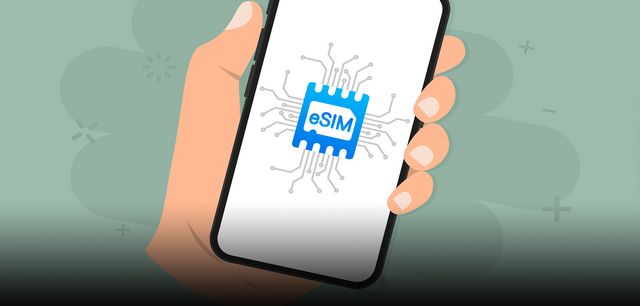09. September 2021
The smartphone goes on, and it’s in with the SIM card: Ever since there have been mobile phones, we’ve had to deal with these little plastic cards. Not for much longer, if the eSIM gets its way. Marc Le Guin from TÜViT explains the advantages it offers and why it is only slowly winning over the doubters.
#explore: What is an eSIM?
Marc Le Guin: The “e” in eSIM stands for “embedded”. Unlike the classic SIM card, the eSIM is permanently installed on the phone’s PCB. So you no longer have to buy a card in the shop or order one online from the mobile phone provider. If you want to conclude a new contract on a Saturday evening, you can do it online – ten minutes later, the contract is activated on your smartphone. The big advantage for mobile operators is that all you need is the corresponding web service. All the card logistics and associated costs are eliminated at a stroke. And if the card slot can be ditched alongside the physical SIM card, mobile phone manufacturers can make their devices even more compact and protect them more easily against dust and water.
„With the eSIM you can easily “move” your contract to the new device. Moreover, it becomes easier to have several mobile phone contracts in place for the same mobile phone.“
Does the eSIM offer any other advantages?
It makes it much easier to switch devices. If you have a mobile phone with a micro-SIM and buy a new smartphone that needs the smaller nano-SIM, you have to order it from the provider first. With the eSIM you can easily “move” your contract to the new device. The annoying business of having to juggle different SIM card formats is thus rendered obsolete. Moreover, it becomes easier to have several mobile phone contracts in place for the same mobile phone. With today’s dual-SIM mobile phones, for example, you can switch between your work and your private number. From a technical point of view, four or five mobile phone contracts can also be bundled on one eSIM. The only limit here is the storage space of the small hard drive in the eSIM.
It was in 2015 that the first eSIM was installed in a smartwatch, followed in 2018 by the first mobile phone. Why hasn’t the technology established itself yet?
Many companies initially shied away from being eSIM pioneers. Although the eSIM will ultimately make things easier for customers, they first have to face up to change – and the prospect of change is often associated with internal resistance. In recent years, however, a lot has happened. To make the transition easier for their customers, the major manufacturers such as Apple, Google or Samsung are at least now installing an eSIM in their flagship phones in addition to the classic SIM card slot.
From September, you will also be able to store your identity card on the eSIM so that you can identify yourself online with government agencies. Could interest in the eSIM rise once again?
How attractive this kind of mobile phone ID is depends of course on what you can do with it. With an electronic identity card, for example, you can already register or re-register your car. But this is a function that hardly anyone knows or uses. The mobile phone ID should now make this even more convenient. In the medium term, of course, it would be a great thing if you could sort out every administrative procedure online. However, Germany hasn’t yet made it out of infancy when it comes to digitalisation. And the users also tend to be on the conservative side. Even though many have been paying by card more often since the beginning of the coronavirus pandemic, we are still one of those countries where most people pay with cash. However, this is increasingly likely to change – after all, our children have grown up with the smartphone as a matter of course. And if citizens’ acceptance of such services grows, this should also drive the expansion of the digital infrastructure in turn.
What role could the eSIM play in the connected devices of the Internet of Things?
In contrast to the consumer market, you’re dealing here with professional users. So, most of the emotional hurdles have already been cleared away. In this respect, the eSIM should prevail much faster here. On the other hand, from my point of view, there’s much to suggest that this will only be a temporary intermediate step in SIM card evolution.
And what might follow the eSIM?
For smartphone manufacturers, the next logical step is the iSIM. Unlike the eSIM, this is not installed on the PCB, but integrated directly into the smartphone chip. As a result, it consumes less energy during operation and takes up even less space. Production costs are also likely to decrease with the iSIM. However, market launch is still some years away. The standardisation processes are lengthy, as many parties are involved and central security issues also have to be clarified. An eSIM can be tested as a single module analogous to a classic SIM card and also has a similar security level. However, if the SIM card is integrated into the mobile’s system, you tend to have to check the security of the whole phone. For this to be done with the required thoroughness but without being ridiculously costly, the security requirements must be precisely defined and specified in advance. And that will take time. Many manufacturers will therefore take the middle path: on the one hand, they will increasingly turn to the eSIM, the advantages of which are already visible today. And yet, on the other, they won’t focus completely on it, as the hope is that the iSIM will follow in the foreseeable future.
These might interest you too:
About Marc Le Guin
© TÜV NORD
Marc Le Guin is Deputy Head of Hardware Evaluation at TÜViT.



